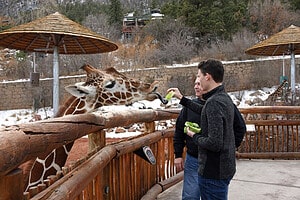
The concept of non-native animals being kept for display is as old as Ancient Egypt. However, today’s modern zoos began developing just a few centuries ago. What are the 4 oldest zoos in the world, and what rare animals do they hold?
Sometime during the eighteenth century, the concept of public zoos started becoming popular. While the history of zoos is sometimes an affront to today’s conservation-focused institutions, zoos still play a valuable role as entertainment and educational venues.
Are there rare animals at the 4 oldest zoos in the world today? We’ll talk a little bit about the history of these zoos and discuss details about some of their rarest current residents.
The 4 Oldest Zoos In The World
These are the four oldest zoos in the world:
- Tiergarten Schönbrunn in Austria
- Ménagerie du Jardin des Plantes in France
- ZSL London Zoo in England
- Dublin Zoo in Ireland
4. Dublin Zoo In Ireland
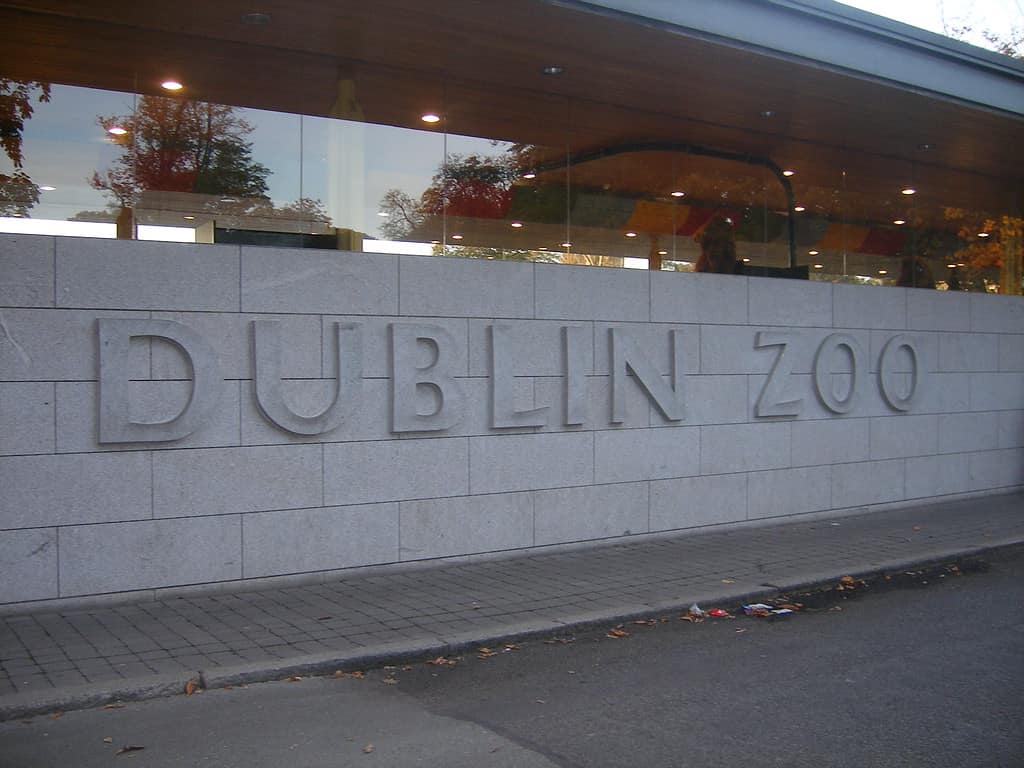
The Dublin Zoo is in Phoenix Park, Dublin, Ireland, and opened in 1830.
©Rparle at the English-language Wikipedia, CC BY-SA 3.0 <http://creativecommons.org/licenses/by-sa/3.0/>, via Wikimedia Commons – License
| Rare Animal Name | Type of Animal | Habitat of Origin | Conservation Status | Fun Fact |
|---|---|---|---|---|
| Dhole (Cuon alpinus) | Wild dog (mammal) | Tropical and temperate environments in Bangladesh, Bhutan, Cambodia, China, India, Indonesia, Laos, Malaysia, Myanmar, Nepal, and Thailand. | Endangered | It only takes Dholes four minutes to eat over two pounds of meat. |
| Eastern bongo (Tragelaphus eurycerus isaaci) | Forest Antelope (mammal) | Forests in the mountains of central Kenya. | Critically endangered | Their unique stripes help them blend in with the streaks of light cutting through trees in the dense forest. |
| Red-ruffed lemur (Varecia rubra) | Small primate (mammal) | Northeastern Madagascar | Critically endangered | Female red-ruffed lemurs have three cones in their eyes, while males only have two. Males are colorblind because of this. |
| Scimitar-horned Oryx (Oryx dammah) | Antelope (mammal) | Northern Africa | Extinct in the wild | As an adaptation to dry climates, these oryx can raise their body temperature by a few degrees to avoid water loss through sweating. |
The Dublin Zoo is in Phoenix Park, Dublin, Ireland, and opened in 1830. The first animals exhibited here were from the London Zoo, which had been established a few years earlier. The initial intention of the Dublin Zoo was to study animals, which continues today alongside an endangered animal breeding program.
A scimitar-horned oryx resides at the Dublin Zoo and is extinct in the wild. Thankfully, reintroduction programs are occurring in Chad, Morocco, Tunisia, and Senegal. The Dublin Zoo directly supports reintroduction efforts in Tunisia and is also an active participant in scimitar-horned oryx breeding programs.
3. ZSL London Zoo In England
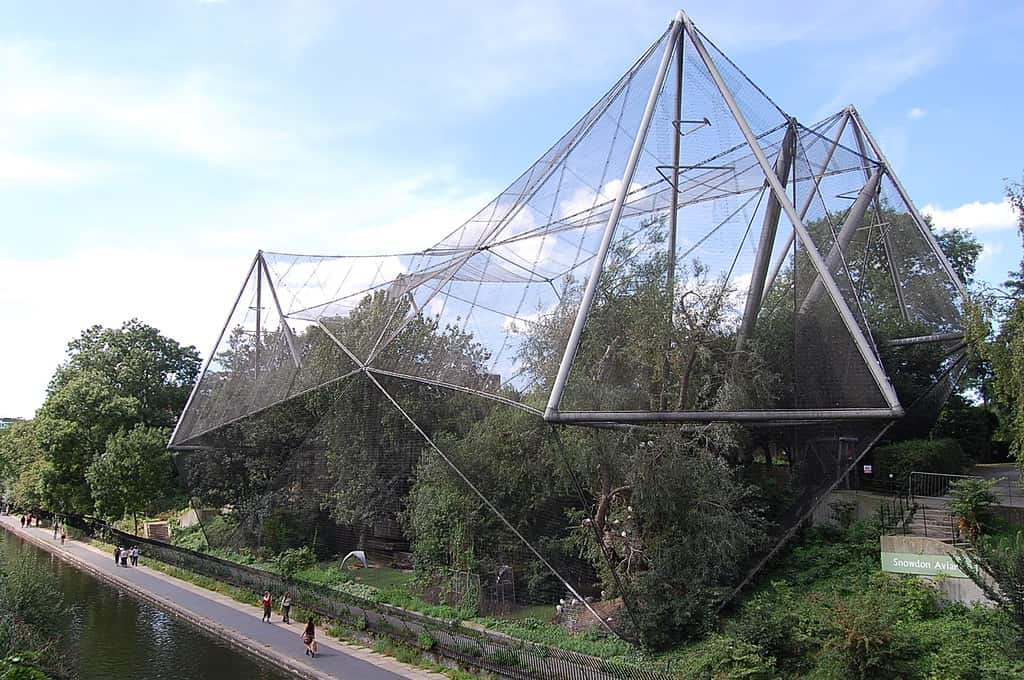
Snowdon Aviary at London Zoo, England
©heena_mistry, CC BY 2.0 <https://creativecommons.org/licenses/by/2.0>, via Wikimedia Commons – License
| Rare Animal Name | Type of Animal | Habitat of Origin | Conservation Status | Fun Fact |
|---|---|---|---|---|
| Okapi (Okapia johnstoni) | Giraffe relative (mammal) | Dense rainforests in the Democratic Republic of Congo. | Endangered | Okapi have dark tongues, which help prevent them from sunburn as they graze. |
| Sumatran tiger (Pathera tigris sumatrae) | Large cat (mammal) | The tropical rainforests on the island of Sumatra in Indonesia. | Critically endangered | Sumatran tigers have the darkest coats out of all tigers. |
| Ethiopian mountain adder (Bitis parviocula) | Venomous Snake (reptile) | Montane forests in southwest Ethiopia. | Unknown because this snake is poorly understood. | Available antivenom neutralizes the venom of this little-understood snake. |
| Partula Snails (genus: Partula) Land snail (gastropod mollusk)Forests on Pacific Islands in French Polynesia and elsewhere. | There are 13 critically endangered species. 11 species are extinct in the wild. 48 species are extinct. | All but 12 species of Partula snails were eaten in a decade by Florida rosy wolf snails in their natural habitat on the island of Tahiti and elsewhere. Florida rosy wolf snails were introduced to control populations of invasive African land snails. It backfired. | Critically endangered and extinct. |
The ZSL London Zoo was created in 1828 in Regent’s Park, London, England. This is the first zoo that wasn’t a result of collections from menageries.
It was developed to closely study animals instead of solely displaying them. Their main goal was to begin the process of classifying animals found in nature. The ZSL London Zoo needed more funding, so the zoo became a less exclusive place of study and was opened to the general public in 1847.
The Ethiopian mountain adder is a poorly understood pit viper endemic to Ethiopia. Discovered in 1976, there isn’t very much scientific data outside of recent observations to explain the intricacies of the species.
Studying the less than 50 captive Ethiopian mountain adders in zoos is vital to understanding more about this snake. The ZSL London Zoo is continuing its legacy of scientific discovery by being one of the main contributors to this understanding.
2. Ménagerie du Jardin des Plantes In France

Ménagerie du Jardin des Plantes In France opened in 1793
©Unknown author, Public domain, via Wikimedia Commons – License
| Rare Animal Name | Type of Animal | Habitat of Origin | Conservation Status | Fun Fact |
|---|---|---|---|---|
| Red Panda (Ailurus fulgens) | It’s in its own family, separate from bears, foxes, and raccoons. (mammal) | These animals live in the temperate zones of the Himalayas in the countries of Nepal, India, Bhutan, Tibet, Myanmar, and China. | Endangered | Somewhere during their evolution, red pandas changed from a carnivorous to an herbivorous diet. They currently have the digestion system of meat eaters even though they eat bamboo. |
| Amur Leopard (Panthera pardus orientalis) | Big cat (mammal) | Temperate forests in the Primorye of northern China and southeastern Russia. | Critically endangered | The papillae on leopard tongues are sharp enough to scrape meat off bones when licked. |
| Przewalski’s horse (Equus przewaskii) | Wild horse (mammal) | The central Asian steppes. | Endangered thanks to reintroduction efforts after they went extinct in the wild. | A population of these horses was released in the Chornobyl Exclusion Zone in Belarus and Ukraine. |
| Rhinoceros iguana (Cyclura cornuta) | Large lizard (reptile) | Hispaniola and other nearby Caribbean islands. | Endangered | When a rhinoceros iguana eats a seed, the digestive process causes some types to germinate faster. This gives those seeds an advantage. |
The Jardin des Plantes is a botanical garden originally owned by Louis XVI that first opened in 1650. It is located in Paris, France.
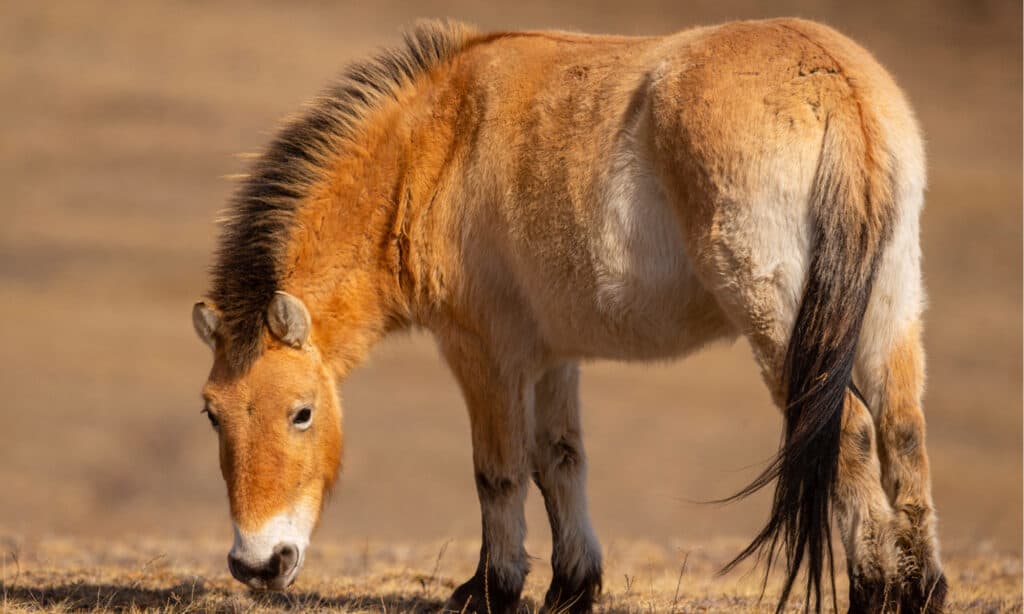
Przewalski’s Horses are endangered species that can be found at the Ménagerie du Jardin des Plantes in France.
©PhotocechCZ/Shutterstock.com
In 1793, a menagerie was created to display the animals of the affluent that existed in the country after the French Revolution. The collection at Versailles and animals brought back during Napoleon’s conquests made up the bulk of early residents.
1. Tiergarten Schönbrunn In Austria
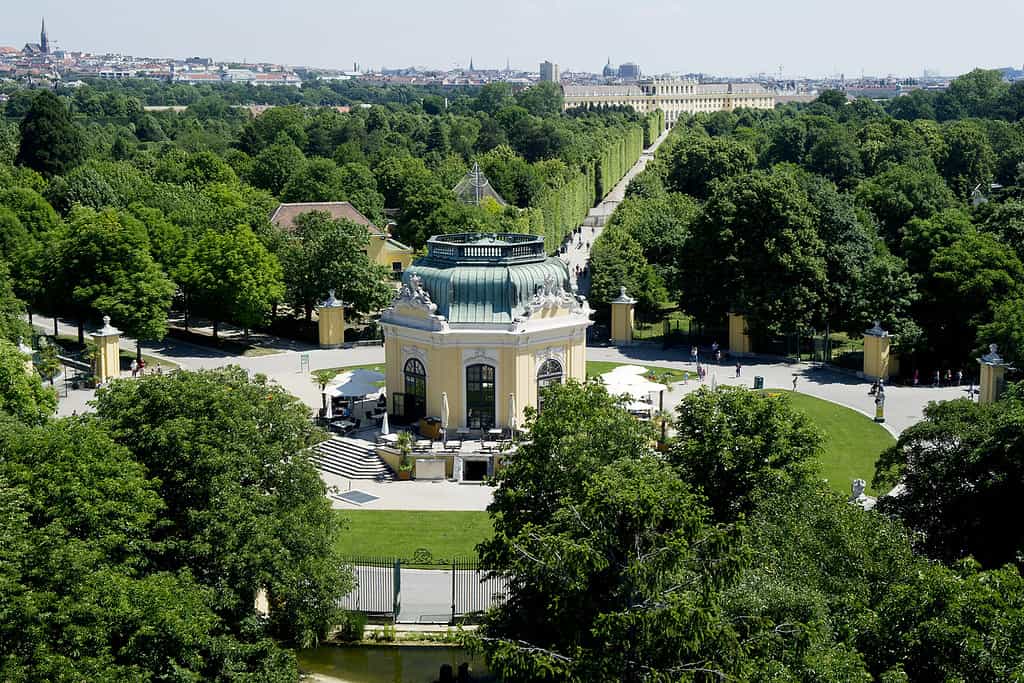
Tiergarten Schönbrunn in Vienna, Austria
,was opened in 1752 and is the oldest zoo in the world.
©Daniel Zupanc, CC BY-SA 4.0 <https://creativecommons.org/licenses/by-sa/4.0>, via Wikimedia Commons – License
| Rare Animal Name | Type of Animal | Habitat of Origin | Conservation Status | Fun Fact |
|---|---|---|---|---|
| Northern bald ibis (Geronticus eremita) | Migratory ibis (bird) | Rocky, barren, and semi-arid environments. Today there is a population in Morocco and a few individuals in Syria though their range used to be much larger. | EndangeredThe nobility considered these birds a delicacy which helped drive them to extinction in Europe by 1650. | |
| Barbary macaque (Macaca sylvanus) | Old World monkey (mammal) | The Atlas mountains in Morocco, Algeria, Libya, and Tunisia. | Endangered | There is a small population of barbary macaques in Gibraltar. These are the only wild monkeys in Europe. |
| Northern river terrapin (Batagur baska) | River turtle (reptile) | Tidal areas of mangrove forests, estuaries, and rivers in Malaysia, Bangladesh, Cambodia, Indonesia, and India. | Critically endangered | River terrapins are being eaten out of existence. Both their meat and eggs are viable human food sources. |
| Azraq tooth carp (Aphanius sirhani) | Killifish (Ray-finned fish) | Azraq tooth carps are endemic to Jordan. They only live in the Azraq Wetland Reserve in shallow water. | Critically endangered | The Azraq Oasis, the original sole habitat of these tooth carp, dried up in the 1990s. |
Tiergarten Schönbrunn in Vienna, Austria, was opened in 1752 and is the oldest zoo in the world. It was established by Emperor Franz I at the Schönbrunn Palace, who wanted a menagerie that reflected his interests in nature. In 1779, the Palace Gardens were opened, allowing the public to view the animals at the zoo.
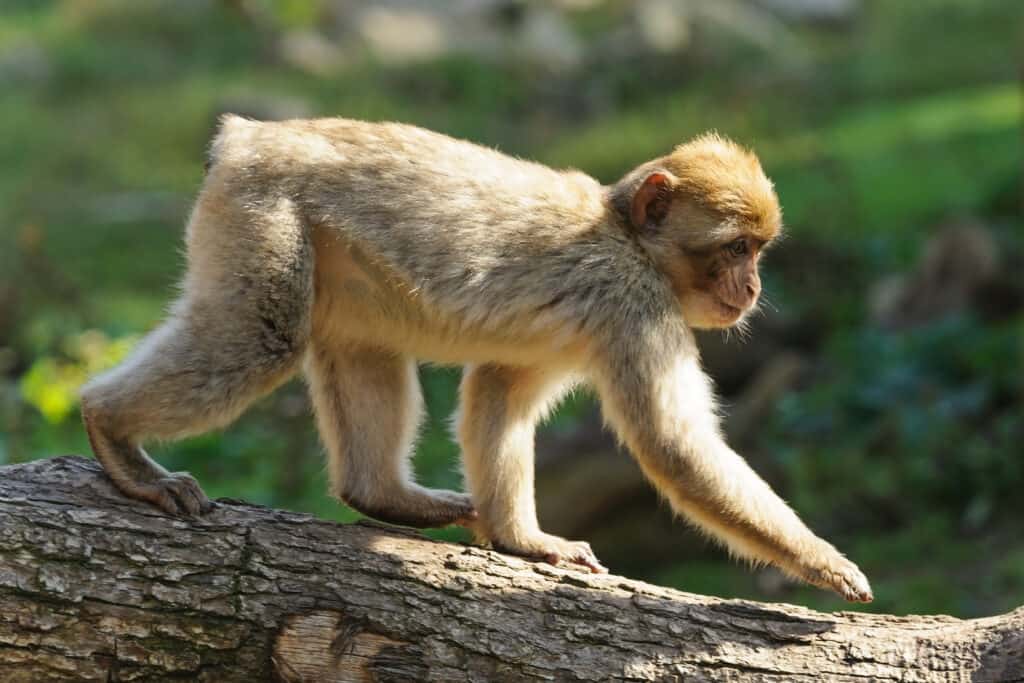
Barbary macaques, like this youngster, have no tails.
©Natalia Paklina/Shutterstock.com
Today, the zoo participates in conservation efforts and breeding programs. It also closely studies large but declining populations of European animals to further attempt to protect those species in their natural habitats.
A Brief History Of Zoos
For centuries, animals were procured by Europeans from abroad and traded among royals and nobles as a show of wealth. Because of this, the idea of viewing caged animals started as a means of displaying status and enticing wonder. Unfortunately, the grueling treks these animals went through, in unfamiliar terrain and climates, to reach their far-off destinations often resulted in stress and death.
As the eighteenth century transitioned into the nineteenth century, interest in science and anatomy was becoming mainstream. As a result, scientists wanted to observe animals closely while also being able to carefully dissect their bodies to understand more about them.
By the twentieth century, the need for conservation and protection came into focus and became the central theme of zoos around the world. Animal welfare at zoos became a top priority, and facilities were greatly expanded to increase living conditions for certain species.
Today, zoos are a beacon for research and education of the natural world to the general population. They also play a big role in fauna conservation. Extensive breeding programs between zoos have resulted in sustained populations of rare animals.
Summary Of The 4 Oldest Zoos In The World
| Rank | Zoo | Date Opened | Rare Animal |
|---|---|---|---|
| 1 | Tiergarten Schönbrunn, Austria | 1752 | Barbary macaque |
| 2 | Ménagerie du Jardin des Plantes, France | 1793 | Rhinoceros iguana |
| 3 | ZSL London Zoo, England | 1828 | Okapi |
| 4 | Dublin Zoo, Ireland | 1830 | Red-ruffed lemur |
The photo featured at the top of this post is © trabantos/Shutterstock.com
Thank you for reading! Have some feedback for us? Contact the AZ Animals editorial team.



